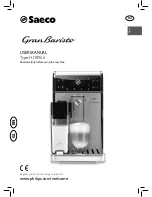
Troubleshooting
(
CONT.
)
Troubleshooting
(
CONT.
)
There are large holes inside the bread
·
This is usually the result of not adding salt to the recipe.
The bread rose too much
·
Try using less yeast (1/4 tsp less at a time). This could also be
the result of not adding salt to the recipe or not placing the
Stirring Paddle into the Baking Pan.
The bread did not rise enough
·
There are several possible solutions. Try using less flour (1 tsp
less at a time), more yeast (1/4 tsp more at a time, or less water
(1 tsp less at a time).
·
You may have forgotten to add salt.
·
Check that the yeast is not expired, and is fresh and properly
stored (sealed, in a cool, dark place).
·
Liquid ingredients may have either been too hot (this will kill
the yeast), or too cold (yeast will not activate). Liquids should
be between 75°F-90°F for best results.
·
The ingredients were in the Baking Pan in the improper
order. If the ingredients are placed improperly, this can cause
the yeast to get wet and not activate. See "Operation Guide"
on pages
12-15
for proper ingredient placement.
The bread has a floured top
·
This is usually a result of using too much flour or not enough
water. Try using less flour (1 tsp less at a time), or try using
more yeast (1/4 tsp less at a time).
The bread is too brown
·
This is usually the result of adding too much sugar to the
recipe. Try using less sugar (1 tbsp at a time). You can also try
selecting a lighter crust color selection.
The bread is not brown enough
·
This is usually the result of repeatedly lifting the lid of the
bread machine or leaving the lid open while the bread is
baking. Be sure the lid is shut while the bread maker is in
operation.
The Stirring Paddle comes out with the bread
·
This can happen, as the Stirring Paddle is detachable. Use
a non-metal utensil or the Paddle Hook to remove it from the
baked loaf before slicing. Use caution, as the paddle will be
hot. Alternatively, you can remove the Stirring Paddle after the
final "Ferment" phase.
The bread is pale on top and collapsed
·
Usually this is because the ingredients are not in balance
or low protein flour is used. Check the method of weighing/
measuring the ingredients. Too much yeast, water or other
liquid ingredients, or insufficient flour, may cause the bread to
be pale on top and collapse while baking.
Bread/jam/yogurt is overflowing in the Baking Pan
·
Results may vary when using other recipes, as the recipes in
this booklet are sized so that the dough is kneaded properly
and the finished bread does not exceed the Baking Pan
capacity. Use only recipes with similar quantities of ingredients.
As a general guide, a minimum of 2 cups and maximum of 4.5
cups of total dry ingredients is recommended on the bread
settings. On the jam setting, as a general guide, a maximum of
3 cups of fruit should be used.
Can I use egg powder or dry milk?
·
Yes, egg powders, dried buttermilk or dry milk can be used.
These products allow you to use the Delay Start feature–
however, always be sure to add the water to the Baking
Pan first, then add the dried substitution after the flour to
keep them separate. Similarly, fresh milk and eggs can be
substituted for dry milk and egg powders, but the baked bread
will have a heavier texture. If you still choose to use fresh milk,
decrease the same measurement of other liquid in the recipe
to avoid runny dough. Do not use the Delay Start feature with
perishable ingredients.
Can other sweetening agents be used in place of sugar?
·
Yes. Honey, golden syrup or brown sugar can be used. When
substituting honey or similar sweet liquids for sugar, ensure to
decrease the same measurement of liquid to equal the liquid
sugar substitute. We do not recommend powdered or liquid
artificial sweeteners.
Can butter or margarine be used in place of oil?
·
Yes, but the bread texture may appear more creamy and
yellow.
Can salt be omitted?
·
Salt plays a very important part in bread making. Omitting
it will decrease water retention in the dough, as well as affect
mixing, the strength of the gluten development and the
fermentation of the yeast. In the finished bread, salt improves
the loaf shape, crumb structure and crust color, as well as
extending shelf life and enhancing flavor.
What if the power goes out during the baking process?
·
If the power goes out for 15 minutes or less while the bread
maker is working, the bread maker's power-off memory will
resume the baking process once power returns.
·
If the power outage lasts longer than 15 minutes, the bread
maker will not be able to resume the baking process. If this
happens, hold down the
Start|Stop
button for 3 seconds
when the power returns. If the display does not return to the
time setting before the outage, unplug the bread maker then
plug it back in. If the machine still does not start, hold down
the
Start|Stop
button a second time for 3 seconds. Continue
to unplug/replug and hold down
Start|Stop
until the display
returns to the cycle time before the power outage. Then, press
Start|Stop
once to resume.
30.
31.
Summary of Contents for ABM-270
Page 17: ...33 32...
Page 19: ...To Enhance and Enrich Lives w w w A r o m a C o c o m...




































